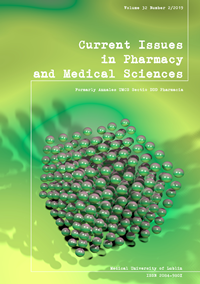Non-carious lesions in patients treated for functional temporomandibular disorders
DOI:
https://doi.org/10.2478/cipms-2019-0015Słowa kluczowe:
non-carious lesions, attrition, abrasion, temporomanidibular disordersAbstrakt
Introduction. Numerous clinical symptoms found in patients with temporomandibular disorders include non-carious lesions, such as V-shaped lesions, wear facets, enamel cracks, and impressions on the tongue or changes in the buccal mucosa. In addition, loosening and dislocation of teeth may occur.
Aim. The aim of the study was to obtain a clinical assessment of the prevalence and severity of non-carious lesions of dental hard tissues (attrition and abrasion) in patients treated for functional temporomandibular disorders.
Material and methods. The clinical research was performed among 45 patients of both genders, aged 16-38 years, treated at the Department of Functional Masticatory Disorders at the Medical University of Lublin, Poland. The study group consisted of 30 patients with diagnosed temporomandibular disorders. The control group included 15 individuals with no diagnosed temporomandibular disorders. The control group was selected Rusing the method of analogues (considering age, gender and dental status). The examinations were performed before the treatment and twelve weeks after its beginning.
Results. The study found significantly higher values of the prevalence and severity of attrition in the patients group, in comparison with the control group (p < 0.05). In the case of abrasion, higher values of the studied variables of prevalence and severity of lesions in the patients, compared to controls, were also found, but the differences were not statistically significant (p > 0.05).
Conclusions. Attrition occurs more frequently and is more severe in patients with diagnosed temporomandibular disorders than in those without such diagnosis. However, no significant differences have been found in the prevalence and severity of abrasion in both groups
Bibliografia
1. Łapuć M, Gołębiewska M, Kondrat W. Częstość występowania i diagnostyka dysfunkcji narządu żucia u pacjentów w wieku 20-30 lat. Doniesienie wstępne. Mag Stomatol. 2011;21(2):12-7.
2. Jagucka-Mętel W, Brzeska P, Kijak E, et al. Terapia dysfunkcji układu ruchowego narządu żucia – problem interdyscyplinarny. Przegląd metod postępowania. Mag Stomatol. 2013;23(1):30-7.
3. Baron S, Walawander T, Baron A, et al. Estetyczno-funkcjonalna rehabilitacja układu ruchowego narządu żucia. Protet Stomatol. 2011; 61(6):459-65.
4. Hryncewicz M, Tropak K. Ubytki niepróchnicowego pochodzenia – abfrakcja, abrazja, atrycja, erozja. Przegląd piśmiennictwa. Nowa Stomatol. 2014;1:46-52.
5. Sierpińska T, Gołębiewska M. Wpływ zaburzeń morfologiczno-czynnościowych układu stomatognatycznego na jakość starcia zębów. Protet Stomatol. 2006;56(5):342-5.
6. Głowacka A, Mustafa ZN, Żak E, et al. Wpływ obecności wad zgryzu, leczenia ortodontycznego oraz zaburzeń okluzji na dysfunkcje stawów skroniowo-żuchwowych – przegląd piśmiennictwa. Dental Forum. 2015;43(1):97-102.
7. Knychalska-Karwan Z. Stomatologia geriatryczna. Kraków: Collegium Medicum UJ;1995:41.
8. Barwińska-Płużyńska J, Kochańska B. Ocena występowania ubytków niepróchnicowego pochodzenia u osób w wieku 55-81 lat, badania wstępne. Czas Stomatol. 2007;60(6):357-66.
9. Rodrigues CA, Oliveira Melchior M, Magri LV, et al. Is the masticatory function changed in patients with temporomandibular disorder? Braz Dent J. 2015;26(2):181-5.
10. Yadav S. A Study on prevalence of dental attrition and its relation to factors of age, gender and to the signs of TMJ dysfunction. J Indian Prosthodont Soc. 2011;11(2):98-105.
11. Mickeviciute E, Ausra Baltrusaityte N, Pileicikiene G. The relationship between pathological wear of teeth and temporo-mandibular joint dysfunction. Stomatologija, Baltic Dental and Maxillofacial J. 2017;19(1): 3-9.
12. Levartovsky S, Matalon S, Sarig R, et al. The association between dental wear and reduced vertical dimension of the face: A morphologic study on human skulls. Arch Oral Biol. 2015;60(1):174-80.
13. Pergamalian A, Rudy TE, Zaki HS, Greco CM. The association between wear facets, bruxism, and severity of facial pain in patients with temporomandibular disorder. J Prosthet Dent. 2003; 90(2):197-200.
14. List T, Jensen RH. Temporomandibular disorders: Old ideas and new concepts. Cephalalgia. 2017;37(7): 692-704.
15. Jonsgara Ch, Hordvika PA, Bergea ME, et al. Sleep bruxism in individuals with and without attrition-type tooth wear: An exploratory matched case-control electromyographic study. J Dent. 2015;43(12):1504-10.
16. Prymas A, Stopa J. Wpływ czynników środowiskowych wewnątrz i zewnątrzpochodnych na powstawanie ubytków niepróchnicowych. Czas Stomatol. 2013;66(2):170-80.
17. Pietruski JK, Pietruska MD. Dysfunkcja narządu żucia – przyczyny, diagnostyka, leczenie. Mag Stomatol. 2013;12:42-8.
Pobrania
Opublikowane
Numer
Dział
Licencja
Prawa autorskie (c) 2019 Autorzy

Praca jest udostępniana na licencji Creative Commons Attribution-NonCommercial-NoDerivatives 3.0 Unported License.


